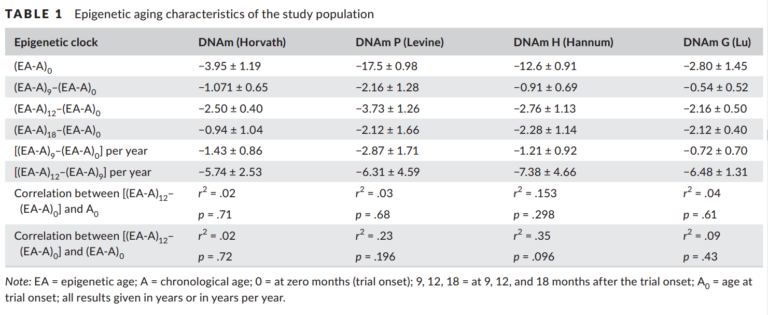.
Josh Mitteldorf says at his 'Aging Matters' blog:
1st Age Reversal Results — Is it HGH or Something Else?
Yesterday, the TRIIM study was described in science news headlines around the world, though, through a glitch, the original research paper is not yet on the Aging Cell web site. (You saw it first here.) I refer you to the writeup in Nature’s News section for a full summary of the paper, and in this column I will add my personal framing, and what I know about the study from private connection to its authors and one of the subjects. The big news is setback of the epigenetic clock, by several methylation measures. Instead of getting a year older during the trial, nine subjects got a year younger, on average, based on the version of the Horvath methylation clock that best predicts lifespan. The study had been originally designed to regrow the thymus. (Loss of thymus function has been linked to the collapse of the immune system that occurs typically before age 70.) Imaging showed that the functional part of the thymus expanded over the course of the trial, and blood tests confirmed improved immune function. The treatment included
- human growth hormone (HGH)
- Metformin
- Vitamin D
- Zinc
- DHEA
It is my belief that the age of our bodies is controlled by several biological clocks. (Greg Fahy, who conceived and conducted the TRIIM study, shares this perspective.) Candidates for clocks include
- Thymic involution
- Methylation profile
- Timekeeper in the hypothalamus
- Telomere length
- Perhaps some changing homeostatic state of signal molecules and transcription factors circulating in the blood
This story is about #1 and #2. To be explicit, I’m saying that the body doesn’t wear out with age, but rather aging is a continuation of the timed growth and development program into a phase of late-life self-destruction. Just as growth and development are under epigenetic control.
Thymic involution
The thymus is a thumb-sized organ just above the sternum where our immune cells are trained to recognize self from other. It is fully developed by the time we are 10 years old, but after that it begins gradually to shrink, simultaneously losing its functional tissue and filling with useless fat. By age 25, it has already lost 30% of its mass, and by age 60 it is less than half its peak size. There is evidence that this is related to the immune decline that contributes so much to growing mortality risk with age, and that reversing that decline might lead to longer, healthier lives. A healthy immune system is important for fighting infection and for eliminating cancer cells before they become tumors. Immune aging may be related to systemic aging in other ways. (Of course, aging affects the immune system, but it also seems that the immune system may be a driving force in other aspects of aging.)

Thus, a rejuvenated thymus might have generalized anti-aging benefits. I first learned this story from Greg Fahy, PhD, chief scientific officer at 21st Century Medicine. and, indeed, he was the first to think of thymic involution as an aging clock, and remains the most enthusiastic and most knowledgable expert on the relationship of the thymus to aging. Twenty years ago, Fahy experimented on himself, and found evidence that he was able to reverse decline of his thymus with HGH=human growth hormone. Ever since, he has wanted to conduct a clinical trial to see if his N=1 result could be replicated.
Methylation aging
Already seven years ago, several of us were speculating [Johnson; Mitteldorf; Rando] that aging is controlled by an epigenetic clock. Epigenetics is gene expression, which changes from moment to moment, from tissue to tissue, and also from young age to old. There are many modes of epigentic control, but the one best studied and easiest to measure is methylation of the cytosine C’s that appear in repetitive islands (C-G-C-G-C-G-C) in our DNA. (Cytosine is the C in ATCG, the four nucleic acids that form the DNA backbone.) Also at this time, Steve Horvath published the first paper using methylation to measure age; Horvath has led in this fast-moving field ever since. I’ve written [here, here, here, and here] about aging clocks based on methylation. The most important things to know are:
- The methylation state of a person’s DNA is the most accurate known measure of his biological age. The latest methylation clocks can predict morbidity and mortality even better than chronolotical age.
- I am among the biologists (still a minority but growing in acceptance) that believe methylation is a prime driver of aging. In other words, changing the methylation state of the body’s cells to a more youthful profile will actually make the body younger.
The TRIIM Study
In 2015, Fahy finally had funding and regulatory approval to replicate his one-man trial in a still-tiny sample of ten men, aged 51-65. That it took so long is an indictment of everything about the way aging research is funded in this country; and not just aging—all medical research is prioritized according to projected profits rather than projected health benefits. The protocol included frequent and extensive testing of many aspects of age-related health. Treatment consisted of:
- Human growth hormone (HGH), 0.015mg/Kg body weight, adjusted individually according to metabolic response. HGH doesn’t survive digestion, so it is self-injected with a tiny needle in the belly
- Metformin, 500mg daily
- Vitamin D, 3000 IU daily (5 times RDA)
- Zinc, 50mg daily (5 times RDA)
- DHEA, 50mg
The hypothesis was that HGH would stimulate regrowth in the thymus. Zinc and vitamin D were added because they are known to enhance immune function. Metformin, a standard diabetes drug, was added because HGH can cause insulin resistance, a pro-diabetic effect. DHEA is a proto-hormone from which all sex hormones and steroid hormones can be made in the body; and blood levels of DHEA decline steadily with age. DHEA is linked to both better immune function and expression of IGF1. The TRIIM paper says that DHEA was added to help counteract any tendency toward insulin resistance, but according to Examine.com, DHEA does not affect the insulin metabolism.
DHEA levels decline with age.
As the study was planned, the primary endpoint was to be thymus size, and so, at considerable expense, MRI images of the thymus were planned up to 5 times during the 12-month study period. Various blood tests were planned to track other metabolic changes, especially to assure that subjects were not being exposed to increased risk of cancer or diabetes. HGH is weakly linked to cancer risk and more strongly to insulin resistance.
Results
Subjects felt a kick from the daily HGH and some reported temporary weight loss and endurance improvement; but the increase in energy was associated with anxiety and insomnia for some. There was no sustained effect on youthful feeling or appearance.
MRI imaging confirmed that, though the thymus wasn’t increasing in size, the functional matrix of the thymus was indeed regrowing at the expense of the fatty, atrophied portion in 8 of the 9 subjects. Several blood tests indicated better immune function.
- C-reactive protein, a marker of inflammation, decreased.
- The ratio of lymphocytes to moncytes is an emerging measure of resistance to cancer, and TRIIM subjects showed a decrease in monocytes.
- Portion of the T cells that wer PD-1 positive went down. PD-1 is a means by which cancer cells shield themselves from the immune system.
This level of success might have led to a modestly encouraging publication, but fortuitously, Fahy made contact with Horvath toward the end of the study, and Horvath volunteered to analyze changes in the subjects’ methylation. (TRIIM had preserved some blood samples from each of the patients at each time point, so this could be done retrospectively.) The result demonstrated a decrease in methylation age, consistent enough to be visible in a sample of only 9 subjects. This was the first time that a treatment in humans led to a setback of the epigenetic clock.
There was no reason a priori to imagine that HGH would affect methylation age, either directly or through its effect on the thymus. If anything, theorists (including Fahy) imagined that the thymus and DNA methylation functioned as indepdent aging clocks.
Fahy reached out to Steve Horvath, who responded with enthusiasm. Horvath did the methylation analysis and the careful statistics that could draw significant conclusions from a marginal effect in a small sample.
Methylation testing procedure: white blood cells are run through a kit that measures methylation at 850,000 sites in the DNA. Then computer programs are used to extract an age from some small subset of a few hundred sites. Once you have done the lab work, the difficult and expensive part is over. Calculating several different methylation ages is as simple as running the appropriate software package.
- At the start of the test, the average epigenetic age of the group was already well below average chronological age. This is presumably because the subjects tended to be highly-motivated anti-aging enthusiasts. Whatever they were doing before the TRIIM study was already working well. By the Levine Clock, they were 17 years (!) younger than their chronological age, and by the GrimAge clock they were 2 years younger.
- A year of extra chronological age would be expected to add one year to the methylation ages, but instead all methylation clocks registered an average decrease in age.
- The so-called Grim Age clock, new this year from the Horvath lab, is the best available measure of life expectancy. By the Grim Age clock, subjects became a year younger while their chronological age was a year older.
- For most of the clocks, the big drop in epigenetic age came during the last three months of the trial (months 9 to 12), raising the possibility that there is a latency period, and a longer trial might produce a bigger drop in epigenetic age.
- After the trial was over, months 12-18, there was a marginal tendency for epigenetic age to “catch up” with chronological age, a loss of the benefit during the test period. The Grim Age clock, arguably the best indicator, did not regress, but held firm at 18 months.

Summary of methylation data from the Aging Cell article.
The Bottom Line
There is no known mechanism whereby HGH is expected to affect the methylation profile. This is not to say that it does not do so, but it is just as viable to think that the combination of vitamin D and Zn is affecting methylation age.
High blood levels of vitamin D and zinc are known to be correlated with lower all-cause mortality and longer life expectancy. Metformin is being investigated in its own right as an anti-aging drug. DHEA has been promoted as an anti-aging supplement for decades, though existing studies indicate DHEA does not increase lifespan in mice. The principal effect of HGH is to increase the hormone IGF1, and DHEA also does this, far more cheaply and over-the-counter, but to a much smaller extent.
HGH is both expensive and theoretically suspect for long-term use. Elevated levels of IGF1 are known to decrease lifespan in rodents; dwarf mice and dwarf humans without IGF1 receptors live longer, healthier lives [ref]. Readers looking to make immediate changes to their personal stack based on the results of this experiment might try the four cheap and proven ingredients, leaving out the HGH for now.
The results are tantalizing, and will certainly motivate follow-up studies, despite the fact that there is no patentable element to the TRIIM protocol. There are five ingredients in the cocktail, all credible, and the interactions among the five are completely unstudied. This first TRIIM study presents good reason to believe that there are anti-aging synergies among some of these ingredients, and it should be an immediate priority to study which among the five are synergizing.
.
Edited by Engadin, 09 September 2019 - 05:06 PM.


















































